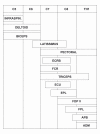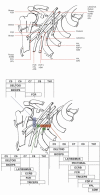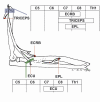Diagnostic accuracy of the neurological upper limb examination I: inter-rater reproducibility of selected findings and patterns
- PMID: 16483371
- PMCID: PMC1402320
- DOI: 10.1186/1471-2377-6-8
Diagnostic accuracy of the neurological upper limb examination I: inter-rater reproducibility of selected findings and patterns
Abstract
Background: We have previously assessed the reproducibility of manual testing of the strength in 14 individual upper limb muscles in patients with or without upper limb complaints. This investigation aimed at additionally studying sensory disturbances, the mechanosensitivity of nerve trunks, and the occurrence of physical findings in patterns which may potentially reflect a peripheral neuropathy. The reproducibility of this part of the neurological examination has never been reported.
Methods: Two blinded examiners performed a semi-quantitative assessment of 82 upper limbs (strength in 14 individual muscles, sensibility in 7 homonymous territories, and mechanosensitivity of nerves at 10 locations). Based on the topography of nerves and their muscular and cutaneous innervation we defined 10 neurological patterns each suggesting a focal neuropathy. The individual findings and patterns identified by the two examiners were compared.
Results: Strength, sensibility to touch, pain and vibration, and mechanosensitivity were predominantly assessed with moderate to very good reproducibility (median kappa-values 0.54, 0.69, 0.48, 0.58, and 0.53, respectively). The reproducibility of the defined patterns was fair to excellent (median correlation coefficient = 0.75) and the overall identification of limbs with/without pattern(s) was good (kappa = 0.75).
Conclusion: This first part of a study on diagnostic accuracy of a selective neurological examination has demonstrated a promising inter-rater reproducibility of individual neurological items and patterns. Generalization and clinical feasibility require further documentation: 1) Reproducibility in cohorts of other composition, 2) validity with comparison to currently applied standards, and 3) potential benefits that can be attained by the examination.
Figures







Similar articles
-
Studies of upper limb pain in occupational medicine, in general practice, and among computer operators .Dan Med J. 2018 Apr;65(4):B5466. Dan Med J. 2018. PMID: 29619928 Review.
-
Diagnostic accuracy of the neurological upper limb examination II: relation to symptoms of patterns of findings.BMC Neurol. 2006 Feb 27;6:10. doi: 10.1186/1471-2377-6-10. BMC Neurol. 2006. PMID: 16504144 Free PMC article.
-
Can testing of six individual muscles represent a screening approach to upper limb neuropathic conditions?BMC Neurol. 2014 Apr 26;14:90. doi: 10.1186/1471-2377-14-90. BMC Neurol. 2014. PMID: 24767511 Free PMC article.
-
Pressure pain thresholds of upper limb peripheral nerve trunks in asymptomatic subjects.Physiother Res Int. 2000;5(4):220-9. doi: 10.1002/pri.202. Physiother Res Int. 2000. PMID: 11129664 Clinical Trial.
-
Neurological diagnosis--aspects of quantitative sensory testing methodology in relation to hand-arm vibration syndrome.Int Arch Occup Environ Health. 2002 Jan;75(1-2):68-77. doi: 10.1007/s004200100279. Int Arch Occup Environ Health. 2002. PMID: 11898879 Review.
Cited by
-
Substantial and reversible brain gray matter reduction but no acute brain lesions in ultramarathon runners: experience from the TransEurope-FootRace Project.BMC Med. 2012 Dec 21;10:170. doi: 10.1186/1741-7015-10-170. BMC Med. 2012. PMID: 23259507 Free PMC article.
-
Determining the level of cervical radiculopathy: Agreement between visual inspection of pain drawings and magnetic resonance imaging.Pain Pract. 2023 Jan;23(1):32-40. doi: 10.1111/papr.13147. Epub 2022 Jul 8. Pain Pract. 2023. PMID: 35765137 Free PMC article. Clinical Trial.
-
Reliability of clinical tests to evaluate nerve function and mechanosensitivity of the upper limb peripheral nervous system.BMC Musculoskelet Disord. 2009 Jan 21;10:11. doi: 10.1186/1471-2474-10-11. BMC Musculoskelet Disord. 2009. PMID: 19154625 Free PMC article.
-
Inter-rater agreement of observable and elicitable neurological signs.Clin Med (Lond). 2014 Jun;14(3):264-7. doi: 10.7861/clinmedicine.14-3-264. Clin Med (Lond). 2014. PMID: 24889570 Free PMC article.
-
The foot in multistage ultra-marathon runners: experience in a cohort study of 22 participants of the Trans Europe Footrace Project with mobile MRI.BMJ Open. 2012 May 22;2(3):e001118. doi: 10.1136/bmjopen-2012-001118. Print 2012. BMJ Open. 2012. PMID: 22619270 Free PMC article.
References
-
- Quintner J, Elvey R. In: The neurogenic hypothesis of RSI. Bammer G, editor. Canberra, National Centre for Epidemiology and Population Health, The Australian National University; 1991. pp. 1–68. (Working Papers No. 24).
-
- The Nerve Injuries Committee of the Medical Research Council . In: Peripheral nerve injuries. Seddon HJ, editor. London, Her Majesty's Stationary Office; 1954. pp. 1–451. (Medical Research Council Special Report Series No. 282).
-
- Strauch B, Lang A, Ferder M, Keyes-Ford M, Freeman K, Newstein D. The ten test. Plast Reconstr Surg. 1997;99:1074–1078. - PubMed
Publication types
MeSH terms
LinkOut - more resources
Full Text Sources
Medical

